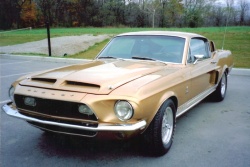 1969 Shelby GT500. Click image to enlarge |
Article and photo by Bill Vance
The Ford Mustang arrived in April 1964 as an early-1965 model and was an immediate success. In spite of humble Falcon underpinnings, its sporty short-deck, long-nose, four-passenger styling appealed to everyone from young families to empty nesters. A six-cylinder engine was standard but with a V8 and many options available, the Mustang could be anything from grocery getter to performance car.
While the Mustang was a runaway sales success that established the Pony Car market, a few enthusiastic Ford executives including Ford Division general manager Lee Iacocca began envisioning a higher performance version. They wanted a racing program to enhance the Mustang’s performance image and make it a rival for Chevrolet’s Corvette.
It wasn’t long before Carroll Shelby’s name surfaced. The tall, former Texas chicken farmer now living in California was well versed in high performance Fords. After a top flight international racing career which included consulting on the successful Ford GT 40 Le Mans project, Shelby had transformed the pretty English AC roadsters into the ultra-fast Ford-powered AC Cobra which he was building in Venice, California. Shelby had the credentials the Ford Mustang needed.
In the fall of 1964 Shelby was contracted to develop what began as the Mustang GT-350, later called the Shelby Mustang 350 and still later just the Shelby GT-350. The 350 name wasn’t of exotic or technical origins, but evolved from a tedious Ford name-the-car meeting attended by an exasperated Shelby. While staring through the window, he asked how far away the building was across the street. It was 350 feet, and the pragmatic Shelby said let’s call it the GT-350.
Shelby and Ford engineers lightened the Mustang, including a fibreglass hood, and removed the rear seat to accommodate the spare tire. They reworked the suspension with stiffer springs and shocks and beefed up the brakes and wheels.
A prototype powered by a Ford 4.7-litre (289 cu in.) V8 was tuned to produce 305 horsepower and fitted with a four-speed manual transmission. It was ready late in 1964 and two types were planned, a street version and a 335-horsepower competition model.
To qualify as a production car for the Sports Car Club of America’s Class B Production racing class, 100 similar examples had to be built. Ford’s San Jose assembly plant sent stripped fastbacks to Shelby who turned them into 350s, and by early in 1965 the required number had been produced.
The Mustang GT-350 proved as successful on the track as regular Mustangs did in the showroom. In 1965 the GT-350 R (racing) versions won the SCCA national championship, much to the chagrin of drivers of Corvettes, Jaguars, Sunbeam Tigers, et al.
Independent GT-350 testers confirmed the GT-350’s performance. Road & Track (5/’65) recorded zero to 96 km/h (60 mph) in 6.8 seconds and top speed of 200 km/h (124 mph). But while R & T found solid performance, they didn’t find much sophistication, summing it up as “…pretty much a brute of a car. There’s nothing subtle about it at all.” And that was the regular GT-350, not the R model (only 30 1965 R models were made), a right-out-of-the-box racer.
In 1966, an automatic transmission was offered, the louvres in the rear quarter area were replaced with glass and brake-cooling air scoops were added ahead of the rear wheels. An optional Paxton centrifugal supercharger boosted horsepower to a claimed 400, but few were sold. The back seat was also reinstalled. Shelbys again won their SCCA class but it was mostly with 1965 cars.
Hertz rental car became interested in the GT-350 and decided that renting them would bring good publicity. Ford thought it may help sell more than the 562 GT-350s sold in 1965. Hertz purchased 936 1966 350s and the Hertz “Rent a Racer” program was born.
In 1967 the Mustang was restyled and softened as Ford started to nudge it into the automotive mainstream, more of a grand touring car than competition machine. A distinctive fibreglass nose was added, two high-beam headlamps were mounted in the grille as well as big hood scoops and a deck spoiler.
The big news under the hood was the availability of a 7.0 litre (428 cu in.) 355-horsepower V8 to create the GT-500. But added weight meant it wasn’t any faster – zero to 100 km/h (60 mph) in 7.2 seconds, according to R & T – and its nose-heavy weight distribution hurt handling. The GT had made the transition from hairy racer to grand touring car.
For 1968 Shelby Mustang production was moved from Shelby’s shop to a plant in Michigan and a new higher performance GT-500 KR (King of the Road) model was introduced. A convertible was also added for 1968.
The Shelby Mustang continued to be sold until 1970. Over six model years just under 11,000 were produced, cars that are now popular and valuable collectibles.








